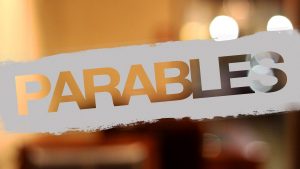The parables told by Jesus are, obviously, in the Gospel books in the New Testament. However, not surprisingly, there’s no such thing as a complete list of the parables of Jesus that all denominations agree on. So, here’s a list of parables Jesus told, from Wilmington’s Book of Bible Lists. 1Willmington, H. L. Willmington’s Book of Bible Lists. Wheaton, IL: Tyndale, 1987.
Since I use the 1984 NIV for the verse text when I write, I also included the NIV specific parable titles when they are different from Wilmington’s list.
Parables told by Jesus is article #1 in the series: Parables of Jesus. Click button to view titles for entire series
Parables told by Jesus
| # | Parable Name | Bible location(s) | Link to article - if it's done. |
|---|---|---|---|
| 1 | Two houses in a hurricane NIV: The wise and foolish builders | Matt. 7:24–27; Luke 6:47–49 | |
| 2 | Forgiving the 50 and the 500 | Luke 7:41–42 | |
| 3 | Subduing a strong man | Mark 3:22–30 | |
| 4 | The sower, the seed, and the soil | Matt. 13:1–9, 18–23; Mark 4:1–20; Luke 8:4–15 | |
| 5 | Satan’s tares in the Savior’s field | Matt. 13:24–30, 36–43 | |
| 6 | From scattering to sickling | Mark 4:26–29 | |
| 7 | The mighty mustard seed | Matt. 13:31, 32; Mark 4:30–32; Luke 13:18–19 | |
| 8 | The cook’s leaven and the kingdom of heaven | Mark 13:33; Luke 13:20–21 | |
| 9 | Finding a fortune in a field | Matt. 13:44 | |
| 10 | The pearl of great price | Matt. 13:45–46 | |
| 11 | Sorting out a sea catch | Matt. 13:47–50 | |
| 12 | A trained man and his treasure | Matt. 13:52 | |
| 13 | A rent cloth and a ruptured container | Matt. 9:16–17; Mark 2:21–22; Luke 5:36–39 | |
| 14 | A generation of gripers | Matt. 11:16–19; Luke 7:31–35 | |
| 15 | The forgiven who wouldn’t forgive | Matt. 18:23–35 | |
| 16 | The Good Samaritan | Luke 10:25–37 | |
| 17 | Seven spirits and a swept house | Matt. 12:43–45; Luke 11:24–26 | |
| 18 | A fool in a fix | Luke 12:16–21 | |
| 19 | Keep the home fires burning | Luke 12:32–40 | |
| 20 | A sinning servant and a returning ruler | Matt. 24:45–51; Luke 12:42–48 | |
| 21 | A fruitless fig tree | Luke 13:6–9 | |
| 22 | Choosing the least at a wedding feast | Luke 14:7–11 | |
| 23 | Two fools and a henpecked husband | Luke 14:15–24 | |
| 24 | A missing sheep, misplaced silver, and a miserable son | Luke 15:1–32 | |
| 25 | The stewings of a steward | Luke 16:1–13 | |
| 26 | The rich man and Lazarus | Luke 16:19–31 | |
| 27 | The master and the servant - aka - When our best is but the least | Luke 17:7–10 | |
| 28 | A widow and a weary judge | Luke 18:1–8 | |
| 29 | A haughty Pharisee and a humble publican | Luke 18:9–14 | |
| 30 | The workers in the vineyard | Matt. 20:1–16 | |
| 31 | Three stewards and their silver | Luke 19:11–27 | |
| 32 | Two sons who changed their minds | Matt. 21:28–32 | |
| 33 | The vicious vinekeepers | Matt. 21:33–46; Mark 12:1–12; Luke 20:9–19 | |
| 34 | A wedding guest with no wedding garment | Matt. 22:1–14 | |
| 35 | The fig tree and the future | Matt. 24:32–35; Mark 13:28–31; Luke 21:29–33 | |
| 36 | Five lamps that went out | Matt. 25:1–13 | |
| 37 | Three stewards and their talents | Matt. 25:14–30 | |
| 38 | Separating the sheep from the goats | Matt. 25:31–46 |

The various articles written are/will be at Parables of Jesus. Given the number of parables Jesus told and the amount of research that goes into each article, it’s going to take a while to do this. So, I hope you get something out of it, but also have patience, as I will continue to write on other topics, both here at God Versus Religion and over on Which god Saves.
Why so much time for research?
Reading a parable from your chosen Bible translation is one thing. Putting ourselves in the shoes of someone who heard that same parable told by Jesus two thousand years ago is quite another thing. My research and writings will take the following things into account.
Common Features in Jesus’ Parables
Jesus’ parables contain many common features:
- Introduced with a question—Jesus spoke many of His parables in response to a question. For example:
- The parable of the Good Samaritan answers “Who is my neighbor?” (Luke 10:30–37).
- The parable of the Mustard Seed answers “What is the kingdom of God like?” (Luke 13:19).
- The parable of the Unmerciful Servant answers “How often shall I forgive my brother?” (Matt 18:23–35).
- Use of everyday images—Jesus’ parables included agricultural imagery that appealed to those in rural settings, as well as urban images such as a judge, a Pharisee, and tax collector praying in the temple; earnings on investments; and a banquet attended by city people.
- Nameless characters—In order to maximize the broad application of His parables, Jesus left His characters generic and nameless. The parable of the Rich Man and Lazarus (Luke 16:19–31) is the only parable that uses a proper name, though it may not be a parable at all.
- Kingdom of heaven—Many of Jesus’ parables describe characteristics of the kingdom of heaven or its citizens. The cluster of short parables in Matt 13:24–52 presents the kingdom as both a present and future reality.
- Shocking punch line—Jesus’ parables often concluded in a shocking manner. Parables were not stories that merely educated, entertained, or satisfied curiosity; they demanded interpretation and application. The closing punch line was designed to convict His listeners and alter their course in life (e.g., “Go and do like the Samaritan” in Luke 10:37; “The tax collector went to his house justified rather than the Pharisee” in Luke 18:14). 2Miller, J. E. (2016). Jesus, Parables of. In J. D. Barry, D. Bomar, D. R. Brown, R. Klippenstein, D. Mangum, C. Sinclair Wolcott, L. Wentz, E. Ritzema, & W. Widder (Eds.), The Lexham Bible Dictionary. Lexham Press.
C.H. Dodd defines a parable as “a metaphor or simile drawn from nature or common life, arresting the hearer by its vividness or strangeness, and leaving the mind in sufficient doubt about its application to tease it into active thought” (Dodd, Parables, 16).
The term “parable” encompasses a broad range of meaning, including full narrative stories, proverbs, riddles, and one-liners. Jesus’ warning against casting pearls before swine may be classified as a parable (Matt 7:6), and His statement about contamination in Mark 7:15 is expressly called a “parable” (Mark 7:17).
However, it is not always possible to restrict a parable to one lesson; the parable of the Prodigal Son and several others were designed with more than one point in mind. 3Miller, J. E. (2016). Jesus, Parables of. In J. D. Barry, D. Bomar, D. R. Brown, R. Klippenstein, D. Mangum, C. Sinclair Wolcott, … W. Widder (Eds.), The Lexham Bible Dictionary. Bellingham, WA: Lexham Press.
I pray this leads to a meaningful experience for you when you go through them with the Holy Spirit.
chris
Footnotes
- 1Willmington, H. L. Willmington’s Book of Bible Lists. Wheaton, IL: Tyndale, 1987.
- 2Miller, J. E. (2016). Jesus, Parables of. In J. D. Barry, D. Bomar, D. R. Brown, R. Klippenstein, D. Mangum, C. Sinclair Wolcott, L. Wentz, E. Ritzema, & W. Widder (Eds.), The Lexham Bible Dictionary. Lexham Press.
- 3Miller, J. E. (2016). Jesus, Parables of. In J. D. Barry, D. Bomar, D. R. Brown, R. Klippenstein, D. Mangum, C. Sinclair Wolcott, … W. Widder (Eds.), The Lexham Bible Dictionary. Bellingham, WA: Lexham Press.
Discover more from God versus religion
Subscribe to get the latest posts sent to your email.
